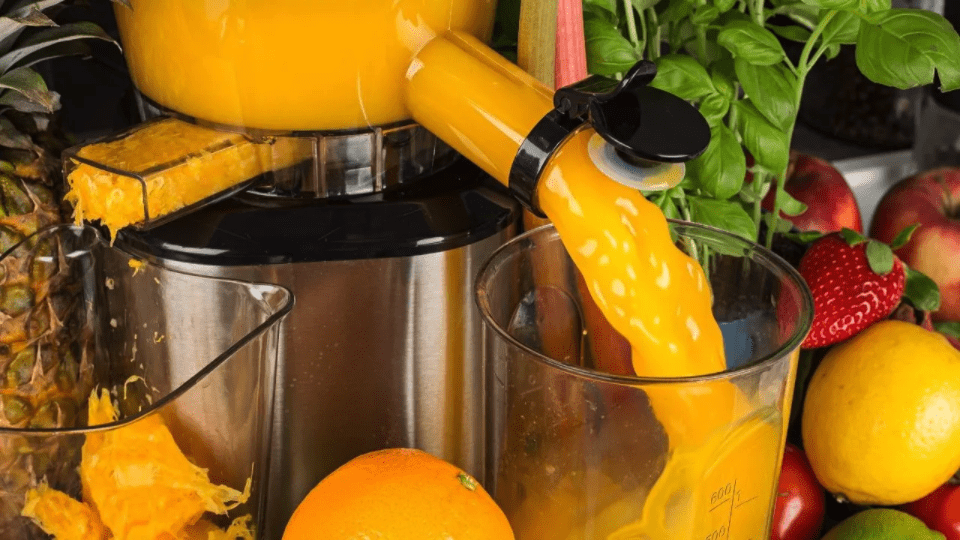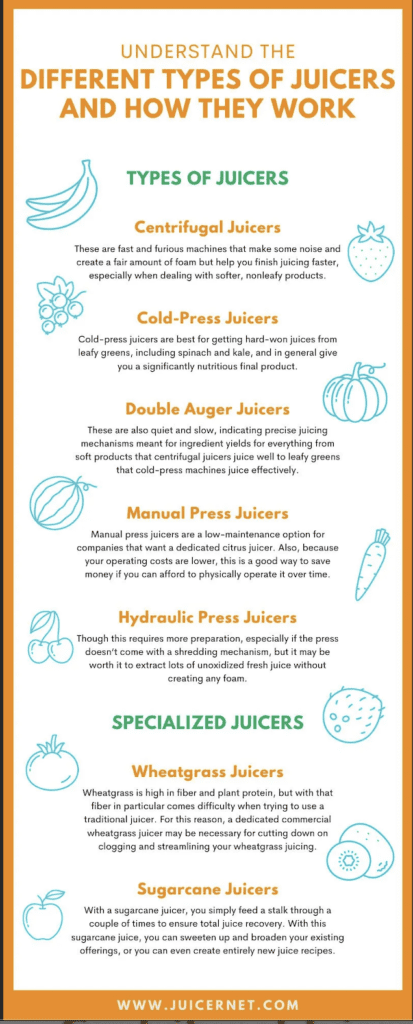nat rosasco • Mar 30, 2020

Juicing is pure and easy. Sure, you need to steer clear of a couple common juicing mistakes to keep your equipment in tip-top shape, but it really is a simple process. In an advanced world where few people understand how their phones work, combining the juice of a couple of different kinds of fruits and vegetables by pressing or grinding them is readily understandable. Not only that, but it’s a pleasantly physical activity when so much of our lives—our digital online lives, for example—are intangible.
That said, when you set out to buy commercial juicing equipment for your business, there are key factors to weigh when choosing what’s best for you. There are many different juicers that specialize in juicing certain products. Once you understand the niche you want to fill and the ingredients you need, read this guide that helps you understand the different types of juicers and how they work.
Types of Juicers
There are specific machines for easily getting the most juice out of certain products. There are other factors at play too: wait time, maintenance, percent juice yield, and more. Here’s a list of general the different types of juicers and how they work.
Centrifugal Juicers
Don’t be scared by bad memories of physics class when you think about centrifugal juicers. They’re really simple machines. Basically, you put your juicing ingredients into the feeding tube where they meet the internal blade. Once your ingredients are ground up and the juice is freed from the fruit or vegetable pulp, the centrifugal juicer’s rotation pulls the juice to the outsides of the circular container and allows it to fall into a collecting container.
These are fast and furious machines that make some noise and create a fair amount of foam but help you finish juicing faster, especially when dealing with softer, nonleafy products. If you want to go with a straightforward process that gets juice into customers’ hands quickly, consider a centrifugal juicer.
Cold-Press Juicers
Meanwhile, cold-press or “masticating” juicers are a slower, more meticulous juicing option than centrifugal juicers. They’re called masticating juicers because their augers mimic the chewing/masticating motion of the jaw in an effort to salvage as much juice as possible. Once crushed, juice proceeds into a collecting container and the pulp ejects into a separate container.
Cold-press juicers are best for getting hard-won juices from leafy greens, including spinach and kale, and in general give you a significantly nutritious final product. They are not as simple as centrifugal devices, but with the added complexity comes less noise and higher juicing yields.
Double Auger Juicers
Double auger, or triturating, juicers are closer to cold-press masticating machines than centrifugal juicers. That said, their unique juicing mechanism allows for broad applications. As you may expect, the trademark of this machine is its dual augers, which first crack open or otherwise expose your juicing ingredients, then go about the slow business of extracting as much juice as possible as the pulp proceeds forward down the corkscrew augers. Like a cold-press juicer, it deposits pulp in a far container while juice drips down below.
These are also quiet and slow, indicating precise juicing mechanisms meant for ingredient yields for everything from soft products that centrifugal juicers juice well to leafy greens that cold-press machines juice effectively. What sets a double auger juicer apart is its flexibility. You can use it for other cooking tasks, including grinding hard seeds and nuts, for example.
Manual Press Juicers
Prefer a more hands-on approach for your juicing business? If so, you can choose a manual press juicer. In a manual juicer, you use a lever system and your own force to juice fruits through a pulp-catching filter and into a collection container. Because you can’t manually juice many vegetables and harder fruits, these are usable as citrus juicers.
Manual press juicers are a low-maintenance option for companies that want a dedicated citrus juicer. Also, because your operating costs are lower, this is a good way to save money if you can afford to physically operate it over time. This may be an attractive piece for your customer experience too. Guests who can see juicing done in this way may come to appreciate the tangible process more than the use of a motor-driven machine. This manual method is simpler and may seem less artificial to customers who value an all-natural process and product.
Hydraulic Press Juicers
Contrary to the physical simplicity of manual presses, hydraulic press juicers are the most sophisticated, or at least the biggest, juicing machines. The key to hydraulic juicers is the immense pressure they apply to ingredients. Some juicers may come with a shredding capability, in which whole spinach leaves, apple slices, and more get ground up into a pulp and passed into a permeable linen bag. This shredding process functions like a cold-press juicer, except its sole function is preparing ingredients for the hydraulic stage. Once shredded, you move these bagged ingredients to a hydraulic lift station. Once set (and folded into place to fit under the press) you engage the hydraulic lift. It slowly raises everything until it meets the top of the lift, whereupon juices fall into a large bowl.
Though this requires more preparation, especially if the press doesn’t come with a shredding mechanism, but it may be worth it to extract lots of unoxidized fresh juice without creating any foam.
Specialized Juicers
There are some ingredients that work best with a specific kind of juicer, such as citrus products with a manual press, while some ingredients, including wheatgrass and sugarcane, require specialized juicers uniquely manufactured to handle them.
Wheatgrass Juicers
Wheatgrass is high in fiber and plant protein, but with that fiber in particular comes difficulty when trying to use a traditional juicer. Wheatgrass occasionally gets caught when going through a cold press, for example. For this reason, a dedicated commercial wheatgrass juicer may be necessary for cutting down on clogging and streamlining your wheatgrass juicing. Also, don’t get the impression wheatgrass machines only juice wheatgrass. They’re effective for juicing spinach, kale, carrots, and hard root vegetables as well.
Sugarcane Juicers
Meanwhile, another similarly tough but valuable ingredient is sugarcane. If you juice significant amounts of sugarcane, you’ll want to consider a sugarcane juicer that typically employs three to four rollers to flatten the juices without needing to shred the tough sugarcane husk. With a sugarcane juicer, you simply feed a stalk through a couple of times to ensure total juice recovery. With this sugarcane juice, you can sweeten up and broaden your existing offerings, or you can even create entirely new juice recipes.


